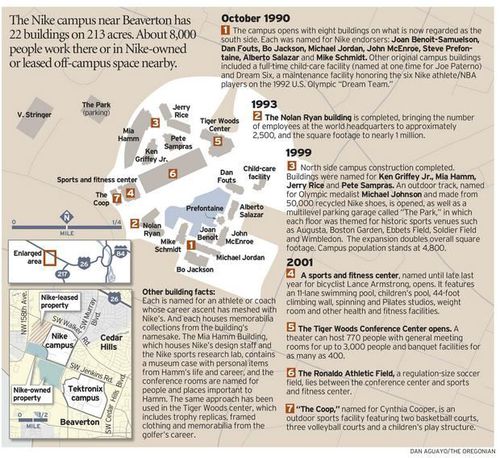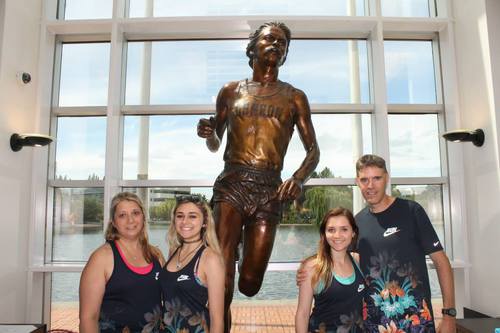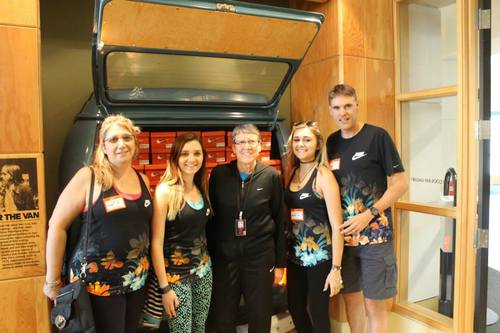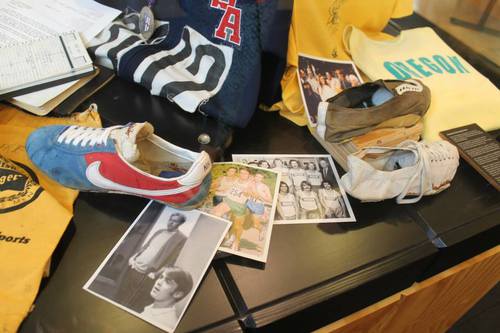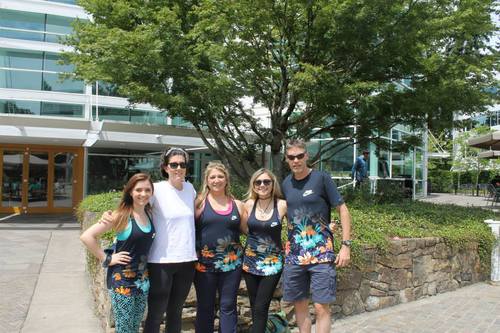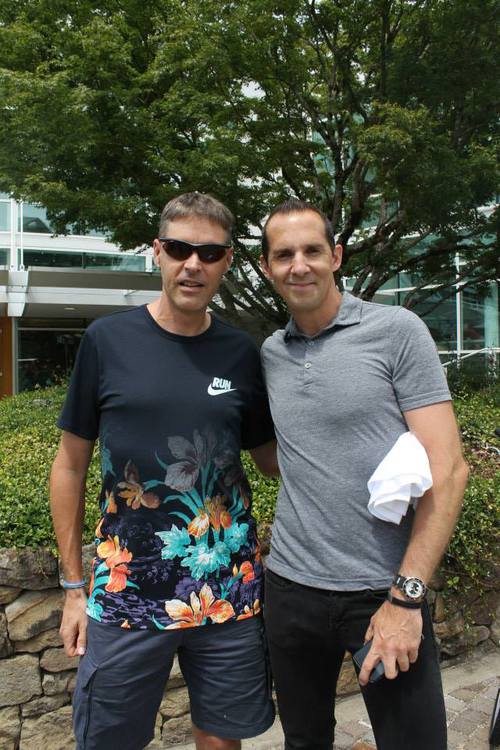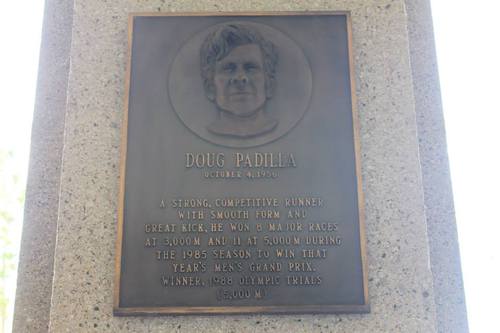The family Benjamin with statue of Steve Prefontaine (Roseann, Amanda, Brianna, Jeff)
Jeff Benjamin has written for me for twenty-five years now. A keen observer of the sport, Jeff gives us a few that many will never see. Jeff is both fan, runner and writer.
He has been quite excited about this story all summer. I have received a few notes from Jeff asking when I was scheduling the story.
I have to admit, I have been to the Nike campus probably fifty times and Jeff’s reverence and observations remind me of how special the campus truly is.
Nice to see Cyndy Poor-Jensen, who I remember on the Cindergals in the mid 1970s, and Margot Fleming, Tom Fleming’s daughter on campus.
The plaques are fascinating to me, and Jeff’s photos of them add to the tour.
Enjoy.
Visiting Phil Knight’s Realm of the Swooshby Jeff BenjaminWhen a family vacation cruise to Alaska finishes up in Seattle with 3 days to spare, what else should one do but visit the Nike Campus Headquarters approximately 2 hours away in Beaverton, Oregon? So we just did it (pardon the pun), and it sure didn’t disappoint. While the company began in the late 60’s as Blue Ribbon Sports but then became Nike in 1971, Nike’s World Campus Headquarters, or, as I like to call it, The “House that Phil Built” was begun in 1990 with eight buildings in October 1990 that cost about $147 million. It has now expanded into something more!The address – One Bowerman Drive, is named for the late University of Oregon track coach and company co-founder Bill Bowerman. The campus is now a 213 acre headquarters. The company’s buildings are named for some of the company’s great athletes- Michael Jordan, Mike Schmidt, John McEnroe and Dan Fouts, to name a few. But the runners are not left out. After all, Nike would not have had their beginnings without them. Buildings named for Joan Benoit, Alberto Salazar and Steve Prefontaine grace the campus as well.As one enters the campus, reserved parking spots list a who’s who from Nike sports–Galen Rupp and even Kenisia Bekele have reserved spots!If one notices, the word “Campus” is a constantly used when visiting Nike Headquarters. “Phil Knight wanted to create the feel of a college campus here, where everyone would feel that they are part of the same team, “said our tour guide Cindy Poor-Jensen, who greeted us in the Steve Prefonaine building which harbors a 10 feet tall statue of the late Oregon track star who was the genisis athletically and spiritually behind the rise of Nike.Perhaps Poor-Jensen’s name rings a bell. Cindy Poor was a 1976 Olympian who qualified for the Games in both the 800 and 1500 meters, competing against contemporaries Jan Merrill and her San Jose Cindergals teammate, Francie Larrieu. She also won the 1500 trials race, coming from behind and passing everyone and setting an American record at the time of 4:07.32. “I always thought it would be a great idea for Nike to set up some kind of tour experience, and I’m very fortunate to be one of the tour guides!”, said the 1977 U.S. Champion at 800 meters.Just like her running, Cindy didn’t disappoint, as she factually and inspiringly covered all the aspects of Nike’s history including Knight, Bowerman, Hollister, Johnson and of course, Steve Prefontaine.Steve Prefontaine memorabiliaInside Nike’s Steve Prefontaine building is a museum which showed all of the vintage pictures of Nike’s development through the early years.Alex Salazar and Jeff BenjaminAll the more enjoyable were all of the artifacts and memorabilia on display from the late 1960’s when Knight’s company was called “Blue Ribbon Sports” right through the 1970’s with the transformation into Nike (Since I don’t want to give away the whole store in this piece, One will have to ask Poor-Jensen or one of the tour guides how the name “Nike” was chosen, along with other questions!).Located in the museum is a replica back end of the car used by Knight and Hollister from which they sold their original shoes out of the back of the trunk; the first Nike shoe, which was a cleat spike; Jackets, spikes, and singlets worn by the late Prefontaine which took up 2 display cases.The original waffle iron used by Bowerman when creating the bottoms of the shoes (“The family found it in the backyard among some junk after he passed away in 1999,” said Poor-Jensen. “They contacted us and asked if we wanted it, and now it’s on display for everyone to see.”); and the story of Phil Knight, a pretty darn good runner himself (4:10 miler) who, through the qualities of grit and determination obviously developed through his running, would rise to transform sports throughout the world.It also helped that he had a very supportive coach, even in his post-collegiate venture of creating Nike. “Coach Bowerman agreed to lend financial help to Phil and he and Phil secured everything on a handshake,” said Poor-Jensen. “Coach Bowerman and Phil never signed any kind of contract.”After the tour, we walked over the campus. When visiting the Alberto Salazar or Joan Benoit buildings, visitors were able to see grand tributes to each of them in their respective buildings, along with cases of memorabilia, including stuff from Salazar’s 3 NYC Marathon victories and Benoit’s Boston, Chicago, and especially the 1984 LA Olympic marathon victories.On our travels through the campus, it was also great seeing some old friends, among them Nike employees Shawn Schmidt and Global DTC Running Service/Experience Manager Margot Fleming (Whose father Tom Fleming was a 2:12 marathoner and won 2 NYC Marathons who then went out to coach 1996 Olympic marathoner Anne Marie Letko and Princeton grad and 10K- Marathon runner Joe LeMay) , along with local Beaverton competitor and coach and fan Dave Ross.Jeff Benjamin and David RossRoss is a familiar person throughout Oregon and the running world, and one of the great 2016 post-Olympic trials events taking place in the area will be his and fiance Stephanie Lowe’s wedding on July 11th, the day after the trials end. Many are invited and many are participating too. After all, what would a Nike Oregon wedding be without the family of Alan Webb? “ Alan’s wife Julia is one of Steph’s bridesmaids and their daughter Joanie is one of our flower girls,” said Ross.Besides going over the “Michael Johnson Track” (yes, the statue of Johnson is replete with gold spikes signifying his 1996 Olympic 200 and 400 meter victories!) and traversing some of the 2-mile wood chip Hollister running trail, one cannot walk away without being impressed and mentioning the various Nike athlete plaques located on the outside walls of almost all of the buildings. Outside of the Steve Prefontaine bulding is a map guide which shows where each of the hundreds of Nike Athletes’ plaques are located.In true Cooperstown-Hall of Fame-like format, the plaques showed the athlete’s sculpted face along with listing their accomplishments. While it was thrilling for me as a Mets fan (Yeah, I know..) to see plaques saluting Dwight Gooden and Gary Carter, runners and track and field athletes were indeed well-represented as well. In a nutshell here are the plaques of some we saw–Ingrid Krisitansen, Lynn Jennings, Said Aouita, Sebastian Coe, Steve Ovett, Steve Cram, Bill Bowerman, Steve Prefontaine, Doug Padilla, Carl Lewis, Mary Decker, Alberto Salazar, Joan Benoit, Michael Johnson, Gail Devers, Jeff Galloway, Herb Lindsay, Dave Moorcroft, Pat Porter, Henry Rono, Alberto Cova, Carlos Lopes, Rosa Mota, just to name a few!!At the conclusion of this whirlwind visit, one could not feel anything but inspired and want to run a hard 10-miler! From their beginnings through the new century, Nike has risen into the dominant sports company on the planet, influencing every sport. But what Knight and company have also done is to not forget the roots from which they and their company came from- running. They have made sure that the legacy of the sport has been well-preserved.
Author

Larry Eder has had a 52-year involvement in the sport of athletics. Larry has experienced the sport as an athlete, coach, magazine publisher, and now, journalist and blogger. His first article, on Don Bowden, America's first sub-4 minute miler, was published in RW in 1983. Larry has published several magazines on athletics, from American Athletics to the U.S. version of Spikes magazine. He currently manages the content and marketing development of the RunningNetwork, The Shoe Addicts, and RunBlogRun. Of RunBlogRun, his daily pilgrimage with the sport, Larry says: "I have to admit, I love traveling to far away meets, writing about the sport I love, and the athletes I respect, for my readers at runblogrun.com, the most of anything I have ever done, except, maybe running itself." Also does some updates for BBC Sports at key events, which he truly enjoys. Theme song: Greg Allman, " I'm no Angel."
View all posts

